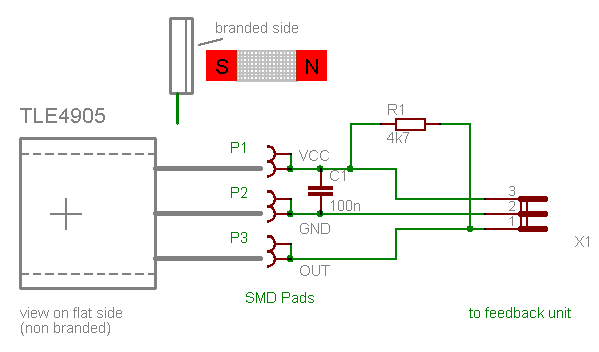Sensors for the Faller Car System
Introduction
-
To detect the position of a Faller Car vehicle the current sensing method as with model railways can't be used.
A simple detection is either performed with light barriers
or magnetic sensors.
More complex methods like RFID or inductive data transmission could also be considered.
- Unipolar means that the sensor get activated from a magnetic field (South Pole) and gets deactivated again if this field is removed.
- Bipolar sensors respond to both poles and hold the last state when the magnetic field is removed.
For our purposes we use an unipolar sensor.
As a source for a magnetic detection, the (existing) driving magnet could be taken into account. The sensor can either be a reed contact or a hall sensor. Following described is the use of an hall sensor. Hall sensors are either unipolar or bipolar:
Hall sensor TLE4905
 The sensor TLE4095 by Siemens is used. This is unipolar hall sensor in the housing P-SSO-3-2,
it is about 4.2 x 4.2mm in size and 1.5 mm thick; The sensor axis with maximum sensitivity is 1.35mm apart of the
upper border.
The sensor has a supply voltage range from 3.8 V to 24V, the output is open collector and can drive up to 50mA.
The sensor TLE4095 by Siemens is used. This is unipolar hall sensor in the housing P-SSO-3-2,
it is about 4.2 x 4.2mm in size and 1.5 mm thick; The sensor axis with maximum sensitivity is 1.35mm apart of the
upper border.
The sensor has a supply voltage range from 3.8 V to 24V, the output is open collector and can drive up to 50mA.

Installation
-
In experiments together with the Faller car front magnet we found out that
a magnetic detection occurs in a field of about 2x2mm around the sensitivity axis of the sensor.
The gap between magnet and sensor may be up to 3mm, if the magnet is in the axis of the sensor.
A guiding wire between magnet and sensor reduces sensitivity, a thick wire (1.5 mm) prevents detection.
So it is recommended to break the wire at the sensor.
The magnetic detection is depends on correct magnet polarity, the sensor must be fitted with the unbranded upwards into the street.
The installation is mad easier with a small connection board.

|
 |
| Bestückungsseite | Lötseite |
Evaluation
-
The sensors are directly connected to the S88 keyboard.
This board is already equipped with a power supply pin for the sensor next to the normal input pin.
A simple pinheader cable with three poles could be used to connect sensor and feedback pcb.